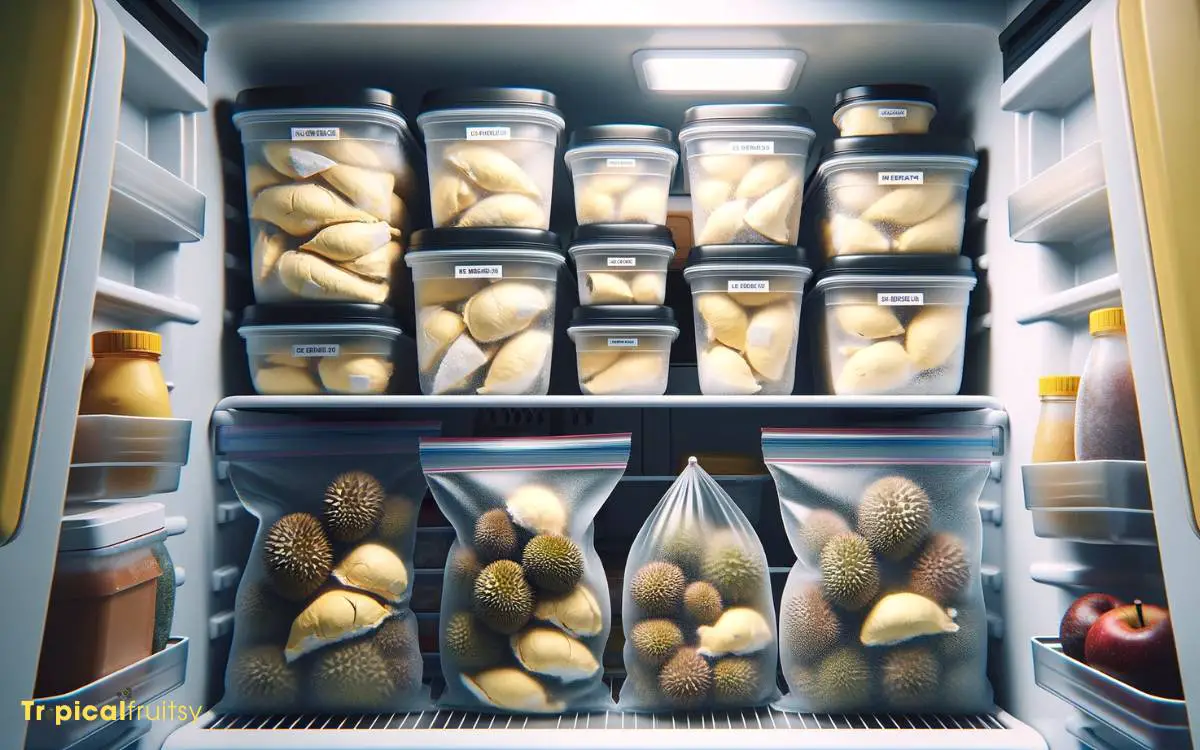How to Eat Frozen Durian? 5 Easy Steps!
To properly enjoy frozen durian, it is essential to know how to select, thaw, cut, and consume the fruit. By adhering to a few straightforward steps, you can experience the full flavor and texture of durian at your convenience.
Selecting frozen durian involves checking for any signs of freezer burn or an off-putting smell. Thawing should be done gradually, ideally in the refrigerator overnight to prevent the growth of bacteria.
When it comes to cutting, using gloves can help manage the fruit’s strong odor and spiky exterior.
Eating durian is best enjoyed fresh after thawing, but if you have leftovers, they should be stored properly to maintain freshness.
Enjoy frozen durian with its unique taste intact by following proper selection, thawing, and storage techniques.

Key Takeaway
Step 1: Selecting the Perfect Durian

Choosing the right durian is pivotal for an optimal taste experience, even when purchasing the fruit in its frozen form.
The selection process should be underpinned by a scrutiny of the fruit’s physical attributes, which serve as proxies for its intrinsic quality.
For instance, the husk should exhibit a uniform coloration, without any pronounced discolorations or blemishes, which could indicate internal spoilage.
Additionally, the spiky exterior should feel relatively firm, bespeaking the fruit’s ripeness and structural integrity.
Furthermore, an olfactory examination is essential; a rich, aromatic scent is indicative of a mature durian, although this characteristic may be subdued in a frozen state.
Lastly, sourcing durians from reputable suppliers with transparent freezing practices can significantly enhance the probability of acquiring a superior product.
Step 2: Thawing Your Frozen Durian

Once a high-quality frozen durian has been selected, the next crucial step is to properly thaw the fruit to ensure its optimal texture and flavor.
Thawing must be approached with precision to maintain the integrity of the fruit’s cellular structure:
Refrigerator Thawing:
- Timeframe: 8 to 12 hours.
- Temperature: Maintain a consistent 4°C (39°F).
- Consideration: Prevents rapid temperature changes, reducing the risk of textural degradation.
Room Temperature Thawing:
- Timeframe: 30 minutes to 2 hours.
- Environment: A cool, shaded area.
- Consideration: Monitor closely to avoid overripening.
Water Bath Thawing:
- Timeframe: 10 to 30 minutes.
- Method: Sealed in a plastic bag, submerged in cold water.
- Consideration: Ensures quick, even thawing while avoiding moisture seepage.
Step 3: Cutting and Preparing Safely

After thawing the durian, one must exercise caution when cutting into the fruit, as its hard outer shell can be challenging to penetrate.
The requisite tools for this operation should include a sharp kitchen knife with a serrated edge and protective gloves to mitigate the risk of injury from the fruit’s spiky exterior.
It is imperative to establish a stable cutting surface to prevent slippage, thereby ensuring a controlled incision.
One should identify the durian’s natural seams, which indicate the weakest points in the husk and provide a guide for the knife’s path.
By applying consistent pressure along these lines, the husk can be safely breached to expose the edible flesh.
Careful technique in this step is critical to avoid compromising the integrity of the fruit segments within.
Step 4: Savoring the Durian Properly

Durian connoisseurs often recommend allowing the thawed segments to reach room temperature for optimal flavor and texture before consumption.
This period of tempering stabilizes the fruit’s complex biochemical composition, enhancing its characteristic taste profile.
Evaluating readiness:
- Aroma: A pungent, distinct smell should be discernible; a sign the fruit’s volatile compounds are active.
- Texture: The flesh should yield slightly under gentle pressure, indicating softness without being overly mushy.
- Color: A uniform, golden hue typically signals peak ripeness and readiness for consumption.
Engaging in a deliberate tasting process allows for a full appreciation of the durian’s multifaceted flavor.
This involves:
- Taking small bites
- Allowing the flesh to rest on the palate
- Breathing through the nose to enhance the taste sensation
Step 5: Storing Leftover Durian

While savoring the durian is an indulgent experience, properly storing any leftovers is crucial to preserve its distinctive flavors and textures for future enjoyment.
To maintain the durian’s quality, one must first remove the flesh from the husk, as the husk can impart additional bitterness upon prolonged storage.
The edible portion should be sealed in an airtight container to minimize oxidation—a process that can degrade the fruit’s taste and nutritional value.
Refrigeration can extend the freshness of leftovers for a few days, but for longer-term storage, deep freezing is recommended.
It is essential to ensure that the temperature is consistently set at -18°C or lower to prevent the formation of ice crystals that can disrupt cell structure, leading to textural degradation upon thawing.
Does Frozen Durian Taste Good

Frozen durian can taste quite good and is a popular way to enjoy this tropical fruit, especially when it’s not in season or when you want a refreshing and creamy treat.
Here are some considerations for frozen durian:
- Texture: Freezing durian can alter its texture slightly. When frozen, durian becomes firmer and less custard-like compared to its fresh counterpart. Some people enjoy the firmer texture, while others prefer the creamy consistency of fresh durian.
- Flavor: The flavor of frozen durian remains intact and is often just as intense and sweet as fresh durian. The freezing process does not significantly affect the fruit’s taste.
- Temperature: Enjoying frozen durian straight from the freezer can be a delightful experience on a hot day. The coldness enhances the refreshing aspect of the fruit.
- Versatility: Frozen durian can be used in various culinary applications. It’s commonly used to make durian smoothies, ice cream, or other frozen desserts. When blended, it can create a creamy and rich base for a variety of dishes.
- Convenience: Frozen durian is convenient because it’s available year-round, regardless of the fruit’s seasonal availability. This makes it an excellent choice for durian lovers who want to enjoy the fruit whenever they like.
- Extended Shelf Life: Freezing durian can extend its shelf life significantly. It can be stored in the freezer for several months without losing its flavor or nutritional value.
To enjoy frozen durian, simply let it thaw for a few minutes at room temperature or microwave it briefly on a low setting to soften it if you prefer a creamier texture. You can then consume it as a standalone treat or use it as an ingredient in various recipes.
Overall, whether frozen durian tastes good is a matter of personal preference. If you already enjoy the flavor of fresh durian, you’re likely to appreciate the taste of frozen durian as well, especially when it’s used in desserts or smoothies.
However, if you’ve never tried durian before, it’s a unique and acquired taste, and whether you like it or not may vary from person to person.
Conclusion
The rigorous process of selecting, thawing, cutting, and savoring frozen durian culminates in an exotic culinary experience.
Proper storage techniques ensure that the king of fruits retains its regal flavor profile for future indulgence.
Adhering to these methodical procedures allows one to enjoy durian at its peak, transforming a spiky exterior into a delicacy that dances on the palate, encapsulating the adage that beauty often lies beneath the surface.






